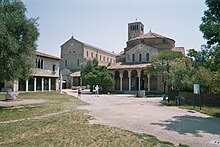Orso Orseolo
Orso Orseolo (* around 988 in Venice , † 1049 in Grado ) came from the influential, Venetian patrician family Orseolo . As Bishop of Torcello , he rebuilt the Cathedral of Santa Maria Assunta on the lagoon island of Torcello in 1008 . He was later made Patriarch of Grado . In 1031/1032 he temporarily took over the reign of his brother, the Doge Ottone Orseolo . He has not been included in the doge lists since modern times.
Life
Orso Orseolo was born in Venice around 988 into an influential tribunician patrician family from which several doges came. Both his grandfather Pietro I Orseolo and his father Pietro II Orseolo were head of Venice.
While his father Pietro II installed his older brother Giovanni as co-regent, Orso started a spiritual career as the second-born. When Giovanni died of the plague in 1007, Pietro Orso's younger brother Ottone was made co-regent. Orso was appointed bishop of Torcello, an island in the northern Venice lagoon, in 1008. Shortly after taking office, he initiated the renovation of the cathedral church of Santa Martia Assunta on Torcello, which he consecrated that same year .
When Pietro died in 1009, Orso's 16-year-old brother Ottone took over as Duca di Venezia e Dalmazia sole reign over a state that had only recently become one of the most important powers in the Adriatic region.
At the same time Orso transferred the relics of Saint Barbara of Nicomedia from Byzantium to St. Mark's Basilica and later to Torcello .
At the instigation of his brother Ottone, Orso was appointed Patriarch of Grado in 1018 at the age of only 30 , and his 20-year-old brother Vitale was his successor on the bishopric of Torcello. As a result of the appointment of bishops, the influential patrician families in Venice resisted Ottones power politics, which initially had no further effects. It was only at the instigation of the influential, anti-Venice patriarch of Aquileia Poppo that Ottone and Orseolo were banished into exile in Istria in 1022 . During his absence, Poppo seized the city of Grado and, with the consent of Pope John XIX , made it subordinate to it . and Emperor Konrad II. their own patriarchate, whereupon the Venetians called Orso and Ottone back from exile in 1023 and reinstated them in their old offices. In the following year, Pope John XIX confirmed. the independence of Grados from Aquileia and Orso in his office as Patriarch of Grado.
After another dispute between Ottone and the Venetian nobility, the latter was exiled to Constantinople. His brothers Orso and Vitale were both removed from their church offices and Orso was temporarily captured.
The foreign policy and economic failures of the newly appointed head of the Republic of Venice, Pietro Centranigo , and his inability to win the Venetians over, eventually led to his removal and the reappointment of Ottones as Doge of Venice. While Vitale was supposed to bring the banished Ottone back from exile in Constantinople, Orso took over the reign of his brother for 14 months in 1031/1032. However, since Ottone died before his return to Venice and Orso, as a clerical dignitary, was not allowed to hold the Doge's office, he tried to establish his nephew Domenico Orseolo as the new Doge. The attempt failed. The Venetian People's Assembly rejected Orso's candidates because they feared the Orseolo family would gain power and wanted to prevent the emergence of a hereditary monarchy.
Although the popular assembly elected Domenico Flabanico , an opponent of Orseolo, as the new Doge, Orso confirmed Orso in his office as Patriarch of Grado. Orso subsequently withdrew from political life and devoted himself exclusively to his spiritual tasks. In 1040 he convened a council during which he reformed his diocese and its associated suffragan bishoprics .
In 1044 there was another attack by Poppo of Aquileia, who took Grado and destroyed it. The expelled Orso turned to Pope Benedict IX. who called on Poppo to give up the conquered territory and to recognize Grado's independence. However, since Poppo died in 1045 and could no longer obey the papal request, Grado was only freed after military intervention by the Doge of Venice, Domenico I. Contarini , and Orso was reinstated in his office.
Orso died in Grado in 1049.
Remarks
- ^ Marion Harland: Where ghosts walk. The haunts of familiar characters in history and literature , Putnam, New York 1898, between pp. 194 and 195.
| predecessor | Office | successor |
|---|---|---|
| Vitalis IV. Candiano |
Patriarch of Grado 1018-1049 |
Dominicus III. Bulzano |
| Valerio |
Bishop of Torcello 1008-1018 |
Vital Orseolo |
| personal data | |
|---|---|
| SURNAME | Orseolo, Orso |
| BRIEF DESCRIPTION | Bishop of Torcello, Patriarch of Grado |
| DATE OF BIRTH | around 988 |
| PLACE OF BIRTH | Venice |
| DATE OF DEATH | 1049 |
| Place of death | Grado |

